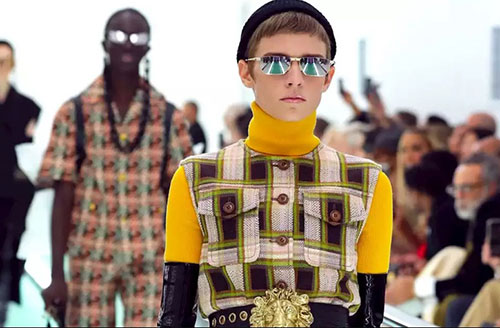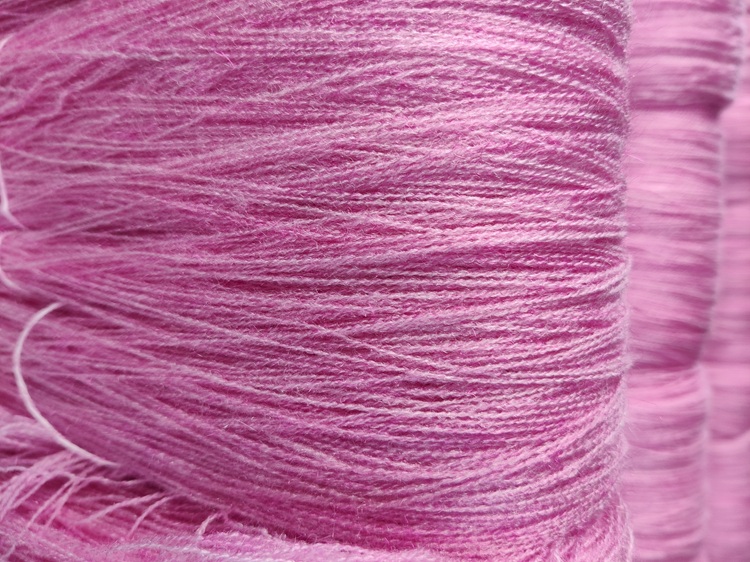FW
According to a report by DGCIS/MOS, the export value of cotton yarn declined by 26.41 per cent to US$ 1,999.21 million during the January-August 2019 from US$ 2,716.77 million in the corresponding period last year. In terms of quantity, the exports declined by 21.99 per cent to 668.44 million kilograms to 856.44 kilograms.
The export value of cotton yarn from April-August 2019 declined by 38.6 per cent to US$1,081 million from US$ 1,762 million in the corresponding period last year. Quantity wise, the country exported 35.7 per cent less cotton yarn during April-August 2019 than 552 milion kilograms exported during April-August 2018.
"For decades, most retailers and brands focused on traditional sizing with a few plus size offerings (beyond size 0-12) often hidden at the back of the store. However, it is no longer acceptable for brands to cater only to a specific size or body type. They are now reaching beyond the norm into new categories and products in terms of size, culture, gender and sustainability. This is offering them new opportunities of revenue generation as Millennials and Generation Z are increasingly investing in these categories."
 For decades, most retailers and brands focused on traditional sizing with a few plus size offerings (beyond size 0-12) often hidden at the back of the store. However, it is no longer acceptable for brands to cater only to a specific size or body type. They are now reaching beyond the norm into new categories and products in terms of size, culture, gender and sustainability. This is offering them new opportunities of revenue generation as Millennials and Generation Z are increasingly investing in these categories.
For decades, most retailers and brands focused on traditional sizing with a few plus size offerings (beyond size 0-12) often hidden at the back of the store. However, it is no longer acceptable for brands to cater only to a specific size or body type. They are now reaching beyond the norm into new categories and products in terms of size, culture, gender and sustainability. This is offering them new opportunities of revenue generation as Millennials and Generation Z are increasingly investing in these categories.
A prime example is H&M criticized for stocking smaller sizes than even most American brands. The brand has now adjusted its sizes to be more in line with American shapes, and launched a plus size line. Similarly, J.Crew, which received widespread backlash for the launch of its infamous size 000 in 2014, has expanded to size 24 across all merchandise. This extension in sizes is not limited to women’s clothing alone. Even menswear brands are tapping into this growing trend. Bonobos, which earlier offered diverse sizes for only women, has now created more inclusive men sizes.
Brands open up to modest fashion
Modest fashion is becoming a huge rage these days. A 2018 study estimates 40 per cent of current women’s luxury ready-to-wear can be categorised as modest or modest-accepted fashion. This is evident from the fact that the designs of Safiya Abdallah, Founder of fashion label Dulce, featured in this summer’s edition of the Cosmopolitan. The magazine described the designer as a ‘proud hijabi-wearing woman opening up a whole world of chic options for Muslim women.’ It also describes the designs of hijab as fresh, fierce and super stylish while still maintaining a modest look.
luxury ready-to-wear can be categorised as modest or modest-accepted fashion. This is evident from the fact that the designs of Safiya Abdallah, Founder of fashion label Dulce, featured in this summer’s edition of the Cosmopolitan. The magazine described the designer as a ‘proud hijabi-wearing woman opening up a whole world of chic options for Muslim women.’ It also describes the designs of hijab as fresh, fierce and super stylish while still maintaining a modest look.
Inclusive fashion also dominates the marketing campaigns and designs of many fashion brands. H&M has developed an entire collection designed on modest clothing. Just like H&M, six other designers engaged in modest fashion were recently profiled by Good Morning America.
Emergence of gender fluid fashion
Just like inclusive fashion, another concept becoming increasingly popular is gender-fluid fashion. Recent data shows, around 38 per cent Gen Z-ers ‘strongly agree’ that gender no longer defines a person as much as it used to, and 27 per cent millennials felt the same. To cater to the growing demand for off gender fashion, brands like H&M, Gucci, Aeropostale, Zara and Prada are launching gender fluid lines. independent designers too are launching own unisex lines. Besides brands and designers, the concept of genderless fashion is also extending to new store formats. Department stores are experimenting with gender-blending styles. Galeries Lafayette, as an example, opened its flagship on the Avenue des Champs-Élysées last spring, and mixed men’s, women’s and unisex sections throughout the floors.
Sustainability and transparency
Just being size inclusive is not enough for brands these days. They also need to be sustainable. Many large brands and retailers like TomboyX, Girlfried Collective, Sotela and Reformation are working to adapt their practices to becoming more sustainable.
Along with sustainability, brands also need to advocate transparency. Their initiatives towards inclusivity need to be legitimate and authentic. They should also embrace different views, races, gender identifications, styles [and] social connections along with sizes.
The Indian apparel industry is worried about duty-free imports of readymade garments from Bangladesh. Bangladesh can export more than 60 products including garments to India, without any duty, under the South Asian Free Trade Area (SAFTA) agreement. These exports have grown 480 per cent in the last five fiscal years. Textile goods produced and sold in India are subject to GST. However, the same products from Bangladesh reach India without any duty and so there is a ten per cent to 15 per cent cost difference between the products.
Many big Indian apparel industry players have set up manufacturing units in Bangladesh and they are also involved in exports to countries that include India. China, though, poses the biggest threat. China uses Bangladesh’s trade advantages to sell its fiber as well as machines. Chinese textile companies provide the fiber and fabrics to units in Bangladesh and get them exported as finished goods to India.
Bangladesh’s share in the international readymade garment market is second only to China’s. Bangladesh enjoys various trade advantages as it is one of the least developed countries. Also, it has the advantage of cheap labor and all these factors have put Bangladesh in second place in readymade garment exports.
The Indian Manmade Yarn Manufacturers Association has demand an increase in import duties as an increase in viscose staple fiber yarn imports to India and low import duties have caused a slowdown for domestic manufacturers.
VSF yarn imports to India have increased by 200 per cent year-on-year in the first five months of the current 2020 financial year. The increase in cheap yarn imports has forced domestic manufacturers to lower their prices, which has led to financial difficulties, especially for the smaller businesses.
There is at least one month of unsold inventory across both large and small spinners who are now contemplating production offs of one-two days a week. An increase in import duty on VSF yarn from 5 per cent to at least 10 per cent will give these spinners a level-playing field to the industry.
The 2019 EURATEX convention focused on the challenges of globalisation, environmental impact and digitalisation, and how these challenges can be turned into opportunities. It addressed a number of topics crucial for the EU and Turkish textile and clothing industry ranging from trade tensions to circular economy and collaboration between designers and manufacturers. The convention featured European and Turkish entrepreneurs, international experts, designers and policy makers who discussed current and future scenarios in the textile and clothing sector.
The 2019 EURATEX convention was organised by the Turkish EURATEX members – TGSD (Turkish Clothing Manufacturers’ Association), TTSIS (Turkish Textile Employers’ Association), IHKIB (Turkish Apparel Exporters’ Association) and ITHIB (Turkish Textile & Raw Material Exporters’ Association). It was attended by over 500 visitors. Panel discussions, testimonials and insightful presentations at the convention allowed participants to have an overview of the sector in Turkey, and opportunities for collaboration both locally and internationally.
Indonesia’s textile sector hopes to be a beneficiary of the trade war between the US and China. The pay off could be a billion dollars or more. But cashing in on the seismic shift in global supply chains won’t be easy for the country’s textile makers. Indonesia is currently battling a slowing global demand for commodities. Indonesia saw exports slump for the tenth straight month in August. Indonesia seems to be lagging in terms of gains from trade diversion and from investments in the new supply chains despite its large labor force, competitive wages and ample land. Bureaucratic regulations, protective labor laws and high trade barriers are handicapping its draw. Indonesia has struggled in comparison to regional rivals in attracting companies wanting to shift out of China. Between June and August this year, 33 Chinese-listed companies announced plans to set up or expand production abroad, with 23 moving to Vietnam alone. The others shifted to Cambodia, India, Malaysia, Mexico, Serbia and Thailand. None moved to Indonesia.
Global firms are pivoting production out of China, which for decades was the world’s workshop. Companies are now scrambling to secure supply lines from other locations like Taiwan, Vietnam, and Bangladesh to skirt the tariffs on US-bound goods.
Stoll, SIFEC and SANDA unveiled a knitting training centre last month at the Shanghai International Fashion Education Centre. An educational platform, the Stoll Knitting Training Centre is jointly built by Shanghai International Fashion Education Centre (SIFEC), Stoll/Chemtax and Shanghai SANDA University (SANDA). The trains knitting design talents of art + technology. It also explores the educational mode of combining production, learning and research.
The Knitting Training Centre also provides knitting design talents with further education and product development in Shanghai and the Yangtze River Delta Region. In future, the centre will provide training to teachers, designers and technicians from the knitting industry with a goal of knitting knowledge transfer.
An internationally operating manufacturer of flatbed knitting machines in Germany, Stoll was founded in 1873 and has about 1,000 employees worldwide. It exports to more than 50 countries all over the world and offers integrated services through affiliated companies, sales and marketing centres and numerous agencies.
SIFEC is one of the few fashion education institutions with a complete fashion industry chain background. It has a powerful team of instructing experts and teachers in textiles and clothing industry and offers a brand-new development model for the perfect combination of novel fashion concepts and experience education.
The Milan Fashion Week hosted a conference to unveil the Denim Institute Milano on September 19, 2019. The conference entitled “Denim, Science, Ethic and Aesthetic” was held at Palazzo Marino and presented some of the partners of the newborn institute founded by Cristian Murianni, alongwith the key leaders of the denim industry.
DIM will collaborate with Milanese fashion school Istituto di Moda Burgo and Università Mercatorum. Its courses will be open to everyone and will its students an opportunity to learn about the denim business. The courses will start from the second week of November and will include the history of denim, tailoring lessons and laboratories organised inside companies. They will be conducted by specialists from the fabric, accessories and treatment industries.
On October 21, the institute will present the schedule of the courses along with a roundtable involving companies, consultants, influencers, designers, retailers and other experts.
Kitex Garments aims at being a top infant apparel manufacturer in the world. The plan is to diversify into socks for children, baby diapers and baby wet wipes. It is planning to add production capacity across the value chain, which includes an expansion of the knitting and processing capacity. The company is also considering setting up a cotton spinning mill for yarn production with a capacity of 100 tons per day. Plans are also afoot to set up a manufacturing facility for ancillary materials such as trims and packages, which includes cartons, tapes, paper tags, labels, hangers, woven tags etc. Kitex Garment is equipped with latest sewing machinery that ensures stain-free, quality sewing, and a state-of-the-art spectrophotometer that ensures electronic color reading and transmission.
The plant produces knitted fabrics that are of exceptional quality, well appreciated and recognized by reputed children’s wear brands in the US and Europe. Established in 1992 Kitex is totally into export of cotton and organic cotton garments, especially infant wear..
Over the last 10 years profit before tax has grown from eight per cent to 21 per cent and it has progressed in terms of technological, operational, human resources, products and social capabilities. Today Kitex is the second largest infant apparel manufacturer in the world.
Drexel University in the US has opened a center for functional fabrics. Engineers, designers, and other scholars are developing models and mass-production techniques for smart textiles that emit, transmit, communicate, and actuate using embedded sensors and other digital tools. It's a modern mini-factory with a warp knitting machine, flatbed knitting machines, circular knitting machines, a textile welding machine, a 3-D scanner loom, 3-D printers and laser printers. The aim is to create textiles of the future with tools of the future. The staff includes fashion designers, material scientists, and mechanical and civil engineers. Drexel is also working on a smart fabric belly band, with a configurable antenna and RFID system (like the antitheft tags in stores) that can detect breathing and contractions in patients not under the direct supervision of nursing staff. A handful of doctoral students are based at the center, along with master's candidates and undergraduate interns. The hope is to join electrical and materials engineering students, fashion designers, and biomedical specialists to learn trans-disciplinary teamwork as well as textile and computing design.
Fabric studded with sensors and entire computing systems is a staple of science fiction and tech promotion. But after years of experiments and lab use, there are few such functional fabric products in commercial production.












